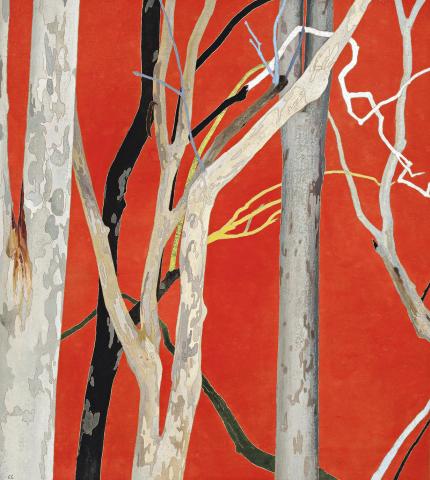SPOTTED EUCALYPTS, ORANGE, 2000
CRESSIDA CAMPBELL
watercolour on incised woodblock
89.0 x 80.0 cm
signed lower left: C.C.
Rex Irwin Art Dealer, Sydney (label attached verso)
Private collection, Melbourne
Cressida Campbell, Philip Bacon Galleries, Brisbane, 14 November – 9 December 2000, cat. 3
Trees, Rex Irwin Art Dealer, Sydney, 2003, cat. 3
Crayford, P., (ed.), The Woodblock Painting of Cressida Campbell, Public Pictures, Sydney, 2008, cat. P0005, p. 346
Spotted Eucalypts, Blue, 2000, watercolour on incised woodblock, 90.0 x 81.0 cm, private collection, Melbourne
Landscape with Spotted Eucalypts, 2000, watercolour on incised woodblock, 91.0 x 81.0 cm, private collection, London
The strongest element of Cressida Campbell’s work, and that which has earned her a cult-like following in recent years, is what Christopher Allen called a ‘pervasive sense of delight in the visual world’1, inherent in each exquisitely detailed woodblock and print that comes out of her studio. Spotted Eucalyptus (Orange) is no exception. A special work within Campbell’s oeuvre, it is a product of perhaps the only instance in which the artist returned to the same scene for the creation of three woodblocks and three prints, one with an intricate wooded view (Landscape with Spotted Eucalypts, 2000), one with a rich blue background, and another one in bold orange.
The densely patterned, naturalistic version illustrated in Campbell’s monograph, is a view from the verandah of the Stella James House in Avalon, designed by Walter Burley Griffin, in which she lived over an extended period of time, including the summer of 1999 – 2000. Her time in this heritage-listed residence also led to the creation of the masterful Walter Burley Griffin House, 1999, featuring its unmistakable bank of Art Deco folding windows. This house, hidden within the lush bushlands of Pittwater in Sydney’s Northern Beaches, is bordered by tall gum eucalypts and angophoras which cover the steep slopes surrounding the cottage. With keen attention to detail and composition, Campbell chose the Eucalypts, including one charred branch, as the heroes of the composition, returning to these to create two more woodblocks and prints with a simplified background of solid colour and a slightly wider field of vision.
In a sublimely balanced composition, the spindly branches of several gum trees are intertwined with their sturdy, mottled trunks. While Campbell usually reserved a simple colour field background for close, detailed studies of individual branches and flowers, for example Gum Blossom, 2000 and White Waratah, 2000, Spotted Eucalypts, Orange provided Campbell with greater artistic licence, allowing for large expanses of deep russet and startling accents of blue and canary yellow. The dense layers so common to Campbell’s landscape vistas are exchanged here in favour of rich colour and an almost abstracted composition, delighting not in naturalism but in pure design. This work displays the analogue woodblock techniques that Campbell learnt at the Yoshida Hanga Academy in Tokyo along with a decidedly Japanese aesthetic. The artist’s unusual technique of hand-painting each unique woodblock with watercolour allows for greater chromatic freedom, situating Campbell’s placing halfway between painting and print-making.
The level of detail, respect for decorative design and refinement of colour all endow Campbell’s familiar domestic and landscape views with an intimate originality. A tightly cropped view, Spotted Eucalypts, Orange is a moment of close attention that the artist extends to the viewer – whose breath is restricted for fear of disturbing the peace of this serene, shared moment.
1. Allen, C., ‘Happy Days’, The Australian, 31 January 2009
LUCIE REEVES-SMITH
